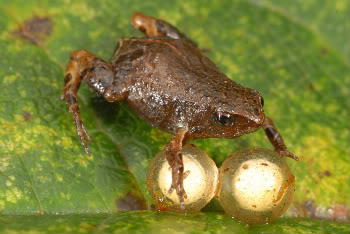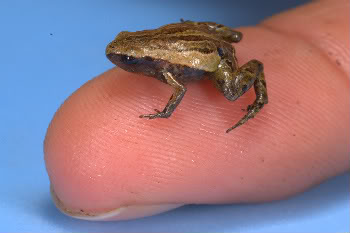At 3,000 meters (9,842 feet) in the Andes herpetologists were surprised to discover a frog so small it could sit on a dime with room to spare. Further study showed that this new species, named Noble’s pygmy frog, is the smallest frog in the Andean mountain range.
The tiny frog took biologists by surprise since as a general rule species in higher altitudes tend to be larger than similar species in lower regions. Measuring at less than half an inch, the Noble’s pygmy frog is not only the smallest frog in the Andes, but one of the smallest vertebrates in the world above 3,000 meters.
 Female Noble’s pygmy frog attending her two eggs. |
Unlike most of her relatives the female Noble’s pygmy frog lays eggs that hatch not tadpoles, but actual infant frogs. Instead of laying hundreds of eggs, she lays only two in a moist place, like under moss or the leaf litter. The mother protects the eggs from drying out and hungry insects.
The status of the Noble’s pygmy frog population is unknown, however the chytrid fungus that has devastated amphibians globally has also taken its toll in Peru. Herpetologists hope the nature of the ecosystems in the Andes allows endangered frogs places to retreat to avoid the plague.
 Male Noble’s pygmy frog on index finger. |
The frog was discovered in the cloud forests of Manu National Park in Peru. The frog inhabits cloud forest, montane scrub, and the high-elevation grasslands located in the park and the privately-owned Wayqecha Research Station. Ten new frog species have been discovered in these cloud forests in the last two years alone.
The new species is described by Edgar Lehr from the Senckenberg Natural History Collections in Dresden and Swiss-Peruvian ecologist Alessandro Catenazzi from the University of California at Berkeley in the latest issue of the journal Copeia.
Citation: Lehr, E., and A. Catenazzi. 2009. A new species of minute Noblella (Anura: Strabomantidae) from southern Peru: the smallest frog of the Andes. Copeia 2009(1): 148-156.
Related articles
Poison frog diversity linked to the Andes
(03/10/2009)
Electric colors, wild markings, and toxic skin have made poison frogs well-known inhabitants of the Amazon rainforest. With 353 recognized species, and probably more awaiting discovery, poison frogs are an incredibly diverse group of amphibians. While it has long been believed that the Amazon basin, itself, was the source of their diversity, a new study published in PLoS Biology has uncovered that the Andes mountain chain has served as an oven of evolutionary biodiversity for poison frogs over several million years.
Photos of new frogs discovered in Colombia
(02/03/2009)
Ten undescribed species of amphibians — including nine frog and one salamander — have been discovered in the mountains of Colombia, report scientists from Conservation International (CI). The “new” amphibians included spiky-skinned, orange-legged rain frog, three poison dart frogs and three glass frogs, named for their transparent skin. The amphibians were discovered during a recent Rapid Assessment Program (RAP) expedition in the Tacarcuna area of the Darien, near the border with Panama.
Green-blooded, blue-boned frog discovered in Cambodia
(12/18/2008)
Researchers have discovered a previously unknown species of frog in Cambodia. The amphibian is unusual in that is has green blood and turquoise-colored bones, a result of its transparent skin and a pigment that may make the species unpalatable to predators, according to Fauna & Flora International (FFI).
The number of endangered amphibians in Peru may be underestimated
(12/01/2008)
The number of threatened amphibian species in Peru may be significantly underestimated, increasing the risk that conservation decisions will fail to account for their needs, report researchers writing in the December issue of Tropical Conservation Science.
7 new species of frog discovered in Ecuador
(10/22/2008)
Seven previously unknown species of frog discovered over the past two years by Ecuadorian researchers are already under threat from habitat loss, reports a newsletter from the IUCN Amphibian Specialist Group.
Good news for amphibians: three new species and one “extinct” frog discovered
(10/01/2008)
Amphibians have received a lot of bleak news recently. Last week a report from the Zoological Society of London and EDGE stated that 50 percent of Europe’s amphibians will go extinct by 2050 unless more is done for their conservation. Meanwhile a report published in August found that one in three amphibians worldwide are threatened with extinction, while 200 species have already been lost since the 1980s. Therefore the discovery of three new frog species and the rediscovery of one thought to be extinct provide a little respite from such bad tidings.